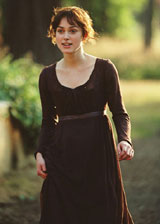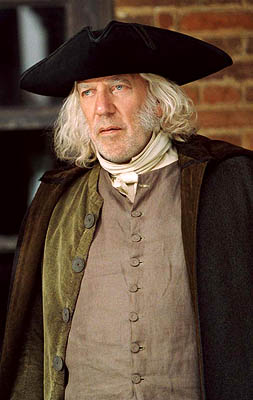Ellen and Jim Have a Blog, Too
We are two part-time academics. Ellen teaches in the English department and Jim in the IT program at George Mason University.


Jane Austen make-overs · 20 November 06
Dear Harriet,
An interim report. Last night I watched the 2005 Universal Pride and Prejudice for a second time (screenplay Deborah Moggach, with a little help with Emma Thompson, directed by Joe Wright, starring Keira Knightley as Elizabeth Bennet, Donald Sutherland as Mr Bennet, Matthew Macfayden as Mr Darcy); this brings me to a total of 6 watched thus far: Amy Heckerling’s 1995 Clueless (Paramount), Whit Stillman’s 1990 Metropolitan, the 1996 Miramax Emma (written and directed by Douglas McGrath, starring Gweneth Paltrow and Jeremy Northam), the 1999 Miramax Mansfield Park (written and directed by Patricia Rozema), Ruth Prawer Jhabvala’s 1980 Jane Austen in Manhattan (an early James Ivory and Ismail Merchant production).
I’ve been doing this by plunging in and catch-as-catch can late at night or afternoon viewing. Once I choose what shall be my perspective I’ll begin rewatching more systematically.
Of books read I’ve gone through all of Troost and Greenberg’s Jane Austen in Hollywood and Sue Parrill’s Jane Austen on Film and Television, most of Pucci and Thompson’s Jane Austen and Co, a selection of essays, some on the novels themselves (including Ruth Perry’s admirable insightful "Interrupted Friendships in Austen," where she takes Emma as her central text), some from more popular periodicals and some from psychoanalytic scholarly types. I’ve embarked on John Wiltshire’s Recreating Jane Austen.
There appears to be very little of the more serious kind of writing on the 2005 P&P. This is a loss since this 2006 P&P makes a number of radical departures in clothing (the 1996 Miramax Emma was the ultimate in designer displays of combining exquisite fashion accuracy with modern sexualized and informalizing qualifications) and presentation of hingepoints (fast, done thrillingly, on the move), and seems to turn to MGM’s landscape swept numinous gothic 1939 Wuthering Heights as its model rather than their cloying screwball comedy (?) 1940 P&P; yet I’ve already discovered that the ending of the film is that found in the witty play written by A. A. Milne called Miss Elizabeth Bennet. And what to make of the continual corridors, dark and oppressive the characters walk through, mirror-like. The biting dialogue. Tom Hollander as an innately-dignified short man made ridiculous and humiliated by his position. I loved as Claudie Blakley, an emotional defensive Charlotte too. All of them with such strain on their faces.
It’s more than making them appropriate to the French revolutionaries and more than making them dirtier and poorer. She is dressed like a boy (in a sort of pea jacket at times) and in dull colors looking frail, fetching, troubled (and on the swing, sly):
In comparison Jennifer Ehle was dressed to look buxom, well-fed self-assured complacent (smug even). In her portrait photos with Colin Firth as Mr Darcy he smolders and looks resentful while she smiles out at us like the cat who swallowed all the cream. They look like a recently married bourgeois couple, and I can see him much more as Mr Palmer from S&S than Austen’s Darcy after marriage.
Sutherland is given weight and strong sexual presence, also troubled (not an elegant self-controlled apparently serene dapper man as Benjamin Whitrow played Mr Bennet in the 1995 P&P):
The problem the 2006 Universal P&P has is that of all the films which made for movie theatre: it’s too short and must telescope and so we miss too much nuance and detail.
Soon I have shall have to decide and then watch the films consecutively according to plan, read again and write an abstract.
I have been intrigued by a modern essay which interprets Emma as a deeply melancholy mourning text centering on the loss of a mother; the description may seem absurd and actually apt for Mysteries of Udolpho but I know I often instinctively or intuitively used to like to say on Austen-l I understood Emma is Austen’s indisputable virtuoso remarkable masterpiece, yet I personally enjoyed Udolpho much more than Emma (bringing them together for comparison though on the surface they seem so unlike), and was struck to find at the center of Clueless a painting of Cher’s mother in grays to whom she apparently talked to on a regular basis.
I also find Amy Heckerling (as Cher’s) witticisms a continual delight: "This is just so not fixable" (I to Jim today staring at our old Microwave which had just died).
How about this: "You can’t do a total makeover. I mean, if the makeover is 5’3" you’re not going to get Cindy Crawford no matter what. Not even the boldest platform can compensate for a six-inch height differential."
Movies don’t work through verbalisms though: they work through projected visual-mood setting, mise-en-scene, and sheer acting presence of the performers, and in a woman’s picture that should be the inward subjective of what’s not said but is in the very rhythms of the structure (e.g., Marie Antoinette as made by Sofia Coppola and Chantal Thomas’s Adieux a la Reine).
How to do this latter project without focusing on an eponymous book as the structure for the essay? Which I have repeatedly written against as misleading and erasing important elements in the films if we are genuinely to see, understand and value them in their own right.
Sylvia
--
Posted by: Ellen
* * *
Comment
- That movies can work through visual mood setting and over narrative vigor is the central focus of Daniel Mendelsohn's review of Sofia Coppola’s Marie Antoinette in the most recent issue of the New York Review of Books, November 30, 2006 (pp. 19-22). Mendelsohn is condescending to the woman director and ends up sneering at her dismissively (he begins as if he’s sorry she got "lost in Versailles"), but he is also thoughtful and makes useful comments film techniques, the icon of Antoinette and the problems encountered in any retelling of her life.
Sylvia.
P.S. See the blog on "Marie Antoinette and Co", review by Diana B for Thursday, November 9, 2006:
http://server4.moody.cx/index.php?id=539
— Sylvia Nov 20, 4:44pm # - Questions:
What elements do you value in the films you take to be cinematic translations or transpositions from Austen and why do you value it? Sophie Thompson as Miss Bates.
What elements in the film go against (contradict, undermine, expose) Austen's books and do you value these? If so, why? The depiction of Mary Bennet in the Universal 2006 P&P.
The book is enriched for me after I have seen the film: the 1995 Miramax S&S.
I also value some of the films in their own right. Parts of Persuasion. Parts of Metropolitan. Clueless as a whole. I delight in the newer ones in general and think I delight in literal fidelity.
Is there something specifically filmic in one or all which adds to Austen? For many readers the mise-en-scene (particularly house and landscape). Problem of act not embodying the dream figure the reader conjured up for the character, which is partly a matter of idiosyncratic identity and history.
The conveyance of a full depth of inward emotional and ethical life through cinematic techniques. This may run the gamut from profound pain to delight. I dislike cruelty and violence offered up for my delectation and will leave a theatre if this is what is on offer.
Mise-en-scene, the actor’s gestures, facial and body expressiveness (close ups are important), voice over, kinds of shots, changes in or single point of view (not the camera's). For me elaborate costumes and hairdos get in the way.
Another way to do this is ask myself, Which films do you want to study? I can answer that after I've read the screenplays, for that is the original skeleton or conception and comparable to the book.
I need to come up with a thesis which begins with film and ends on Austen through which I can hitch the best films together.
Elinor
— Sylvia Nov 21, 3:14pm #
commenting closed for this article


